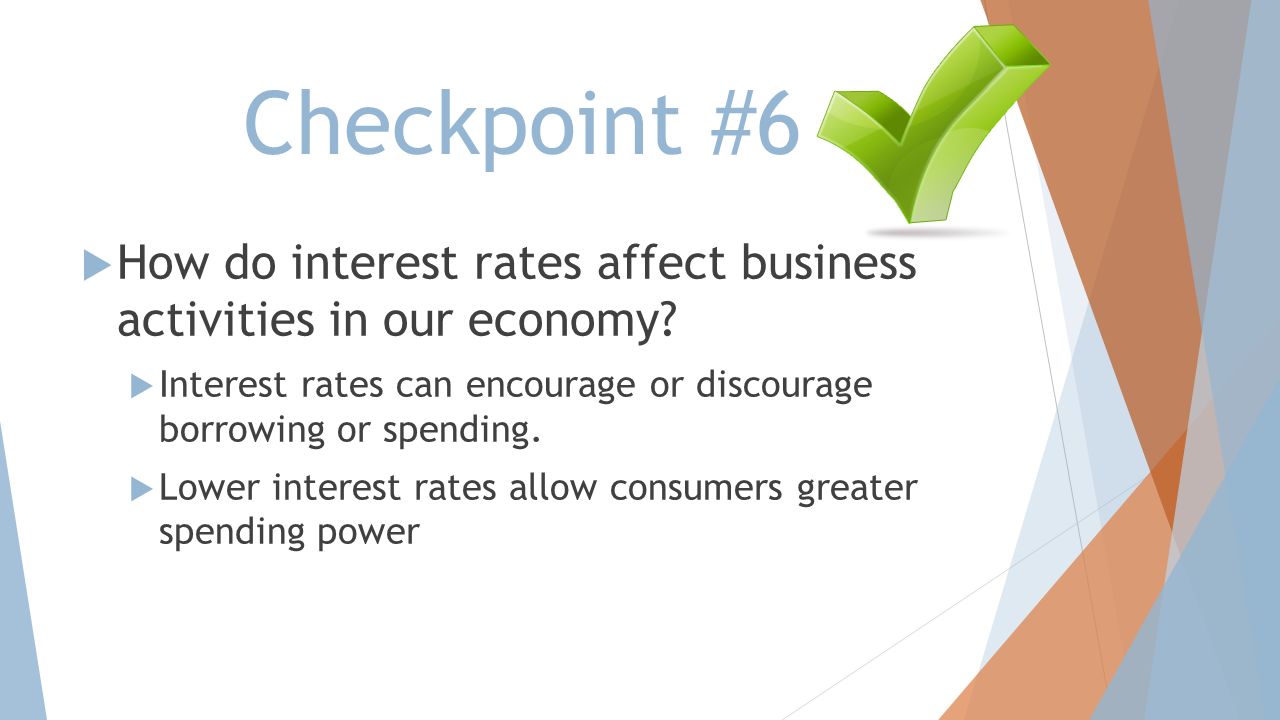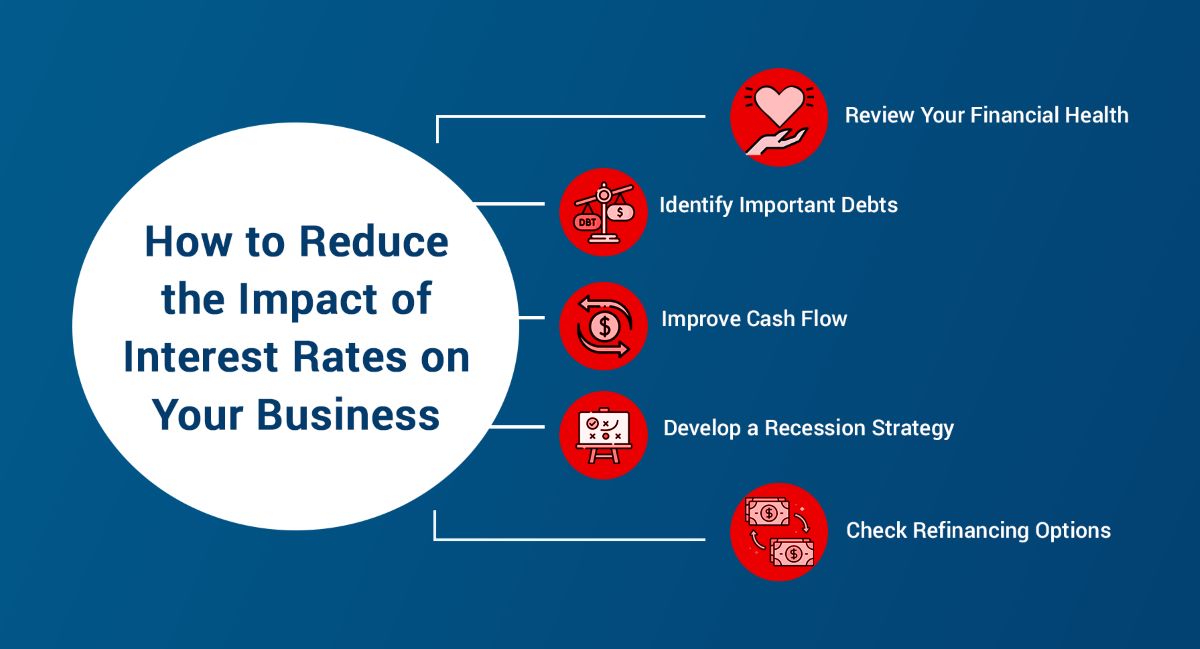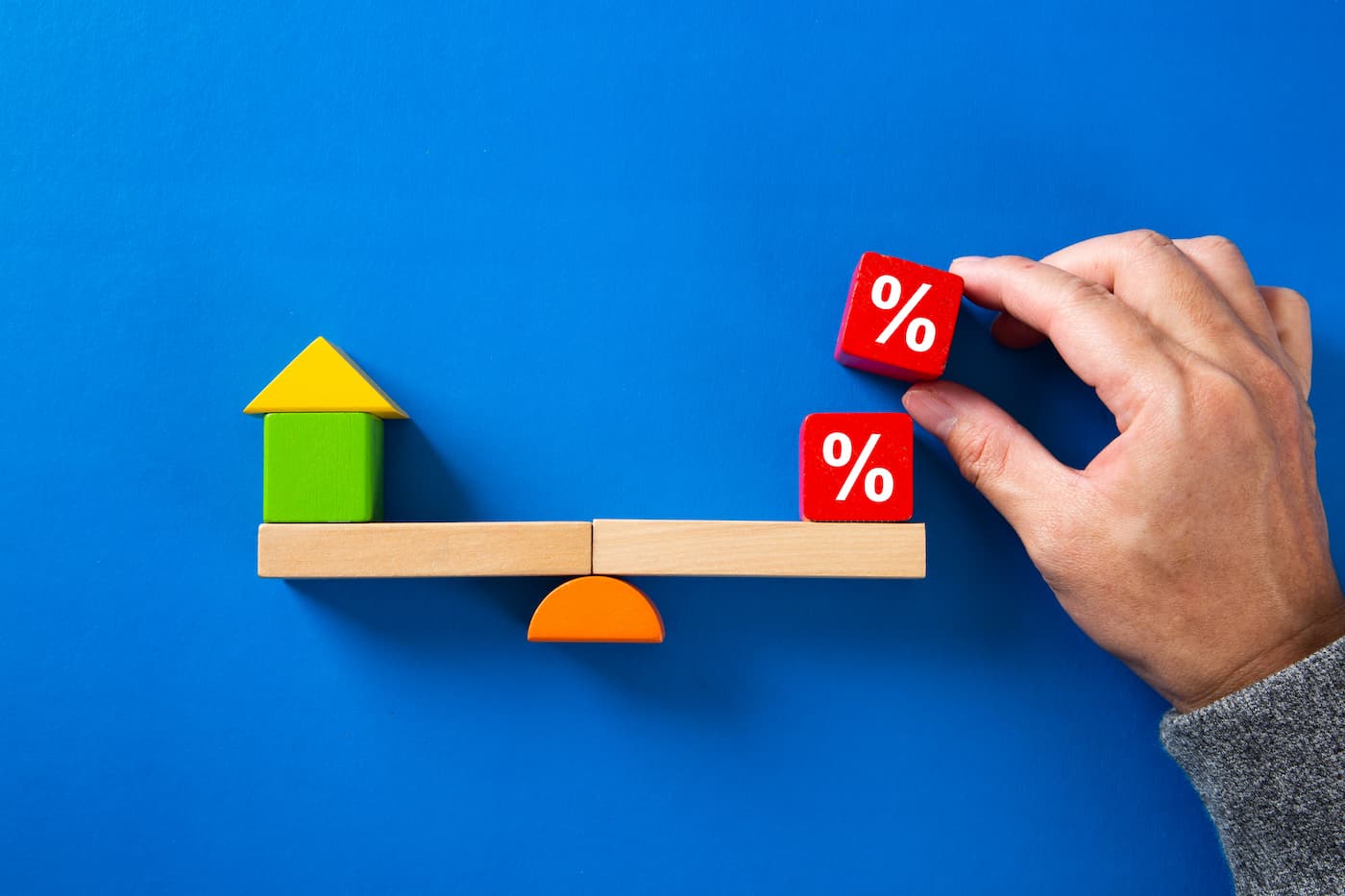Home>Finance>How Do Interest Rates Affect Business Activities In Our Economy?


Finance
How Do Interest Rates Affect Business Activities In Our Economy?
Published: November 1, 2023
Learn how interest rates impact business activities in the economy and stay up-to-date with the latest finance trends. Gain valuable insights and make informed decisions for your business.
(Many of the links in this article redirect to a specific reviewed product. Your purchase of these products through affiliate links helps to generate commission for LiveWell, at no extra cost. Learn more)
Table of Contents
- Introduction
- The Role of Interest Rates in the Economy
- Impact of Interest Rates on Business Investment
- Influence of Interest Rates on Consumer Spending
- Effects of Interest Rates on Borrowing and Lending
- Interest Rates and Profit Margins in Business
- Impact of Interest Rates on Exchange Rates
- Interest Rates and Inflation
- Effect of Interest Rates on the Housing Market
- Conclusion
Introduction
Interest rates play a crucial role in shaping the overall economic landscape of a country. Governments and central banks use interest rates as a tool to control inflation, stimulate economic growth, and maintain financial stability. Understanding the impact of interest rates on business activities is vital for entrepreneurs, investors, and consumers alike.
Interest rates are the cost of borrowing money or the return earned on lending funds. They affect various aspects of the economy, including business investment, consumer spending, borrowing and lending, profit margins, exchange rates, inflation, and the housing market. Changes in interest rates can have a significant ripple effect on these areas, shaping the behavior and decisions of businesses.
In this article, we will delve into the impact of interest rates on different aspects of business activities in our economy, examining how fluctuations in rates influence investment decisions, consumer behavior, borrowing costs, and overall profitability.
By understanding the intricate relationship between interest rates and business activities, individuals can make informed decisions, adapt strategies, and navigate the ever-changing economic landscape with greater confidence.
The Role of Interest Rates in the Economy
Interest rates are a fundamental tool used by central banks to manage the economy. They play a crucial role in influencing the borrowing and lending behavior of businesses and individuals, which in turn affects the overall economic activity. Here are some key roles of interest rates in the economy:
- Controlling Inflation: Central banks often raise interest rates to curb inflation. When interest rates rise, the cost of borrowing increases, resulting in reduced consumer spending and business investment. This helps to slow down the economy and control inflationary pressures.
- Stimulating Economic Growth: On the other hand, central banks may lower interest rates to encourage borrowing and stimulate economic growth. Lower interest rates make it cheaper to borrow, prompting businesses to invest in expansion, innovation, and hiring. Additionally, lower rates also encourage consumers to spend, boosting overall economic activity.
- Maintaining Financial Stability: Interest rates are integral to maintaining financial stability. By adjusting rates, central banks can influence asset prices, such as stocks and real estate. Moderate interest rates help prevent speculative bubbles and promote a stable financial system.
- Managing Exchange Rates: Interest rates can influence exchange rates. Higher interest rates attract international capital, leading to increased demand for a country’s currency. This can strengthen the currency’s value, making imports cheaper and exports more expensive. Conversely, lower interest rates can weaken the currency, boosting exports and making imports more expensive.
Overall, interest rates act as a mechanism to balance economic growth, inflation, and financial stability. Central banks carefully evaluate economic indicators and make adjustments to interest rates accordingly. This helps in steering the economy towards sustainable growth and managing potential risks.
Impact of Interest Rates on Business Investment
Interest rates have a profound impact on business investment decisions. When interest rates are low, it becomes more affordable for businesses to borrow money for investment purposes. This can lead to increased business investment in equipment, technology, research and development, and expansion.
Low interest rates also tend to encourage entrepreneurial activities. Start-ups may find it easier to secure funding and venture into new business ventures when borrowing costs are low. This can foster innovation, job creation, and overall economic growth.
On the contrary, high interest rates can deter businesses from taking on new investments. Higher borrowing costs can strain budgets and reduce the available funds for expansion. This can lead to companies delaying or scaling back investment plans, which in turn can have a dampening effect on overall economic growth.
Moreover, the availability of credit plays a significant role in business investment decisions. When interest rates are high, financial institutions may tighten their lending criteria, making it more challenging for businesses to secure loans. This lack of access to credit can limit the ability of businesses to fund their investment projects and grow their operations.
Business investment decisions are also influenced by expectations of future interest rate movements. If businesses anticipate that interest rates will rise in the future, they may accelerate their investment plans to take advantage of lower borrowing costs before rates increase. Conversely, if businesses expect interest rates to decrease, they may delay investment decisions until borrowing costs become more favorable.
Overall, interest rates have a significant impact on the level of business investment. The cost of borrowing, access to credit, and expectations of future interest rate movements all play a role in shaping the decisions made by businesses regarding capital expenditures and expansion plans.
Influence of Interest Rates on Consumer Spending
Interest rates have a direct impact on consumer spending patterns. When interest rates are low, it becomes more affordable for consumers to borrow money, leading to increased spending on big-ticket items, such as houses, cars, and durable goods. Lower interest rates reduce the cost of monthly loan payments, making it easier for individuals to finance their purchases.
Moreover, low interest rates can also encourage consumers to borrow for discretionary spending, such as vacations, home renovations, and other non-essential purchases. As borrowing costs decrease, consumers may feel more confident in taking on additional debt to fulfill their desires and aspirations.
On the other hand, high interest rates can have the opposite effect. When borrowing costs are high, consumers may be more hesitant to take on new debt and may prioritize paying down existing loans. This can lead to decreased consumer spending, as individuals allocate more of their income towards debt repayment rather than discretionary purchases.
Additionally, high interest rates can affect consumer sentiment and confidence. When interest rates rise, it can signal tighter monetary policy and potential economic slowdown. This can make consumers more cautious about their spending habits, as they become concerned about future financial stability and uncertainty.
Influence of Interest Rates on Consumer Spending
Interest rates also impact the housing market, which plays a significant role in consumer spending. Lower interest rates can make buying a home more affordable, as mortgage payments decrease. This can lead to increased demand for housing, driving up prices and stimulating the construction and real estate sectors. Higher interest rates, on the other hand, can reduce affordability, potentially dampening demand in the housing market.
Furthermore, interest rates affect the cost of credit card debt and other forms of consumer loans. When interest rates are low, consumers may be more willing to carry higher levels of debt, leading to increased spending on credit cards and personal loans. Conversely, when interest rates are high, consumers may prioritize debt repayment and reduce discretionary spending.
Overall, interest rates have a significant influence on consumer spending patterns. Low interest rates can encourage borrowing, stimulate the purchase of goods and services, and boost economic activity. Conversely, high interest rates can curb consumer spending, particularly on big-ticket items, and impact overall economic growth.
Effects of Interest Rates on Borrowing and Lending
Interest rates have a direct impact on the cost of borrowing and lending money. When interest rates are low, borrowing becomes more affordable and attractive to businesses and individuals. Conversely, high interest rates increase the cost of borrowing, potentially discouraging borrowing activity. Here are some effects of interest rates on borrowing and lending:
- Borrowing Costs: Interest rates determine the amount of interest that borrowers have to pay on their loans. Lower interest rates reduce the cost of borrowing and can incentivize businesses and individuals to take on new debt for investments, purchases, or other financial needs. Similarly, higher interest rates increase borrowing costs and may limit borrowing activity.
- Lending Returns: Higher interest rates tend to increase the returns for lenders and investors. This can attract capital from lenders, as they seek to earn higher interest income. Conversely, lower interest rates can reduce the returns on lending, potentially discouraging lenders from providing loans.
- Access to Credit: Interest rates can also impact the availability of credit. When interest rates are low, lenders may be more willing to extend credit to borrowers, as the risk of default may be lower. Conversely, when interest rates are high, lenders may be more cautious and tighten their lending criteria, making it more challenging for borrowers to access credit.
- Debt Servicing: Fluctuations in interest rates can also affect the ability of borrowers to service their debts. When interest rates rise, the cost of servicing existing loans increases, potentially straining borrowers’ budgets. This can lead to increased debt burdens and financial stress for individuals and businesses. Conversely, when interest rates decrease, borrowers may experience relief in their debt servicing obligations.
Furthermore, interest rates influence the behavior of borrowers and lenders in terms of their risk appetite. Lower interest rates may encourage borrowers to take on more debt, potentially increasing the risk of defaults and financial instability. Higher interest rates, on the other hand, can incentivize borrowers to be more cautious and conservative in their borrowing activities.
In summary, interest rates directly impact the cost of borrowing, the returns on lending, access to credit, and the ability of borrowers to service their debts. Businesses and individuals must carefully consider interest rate movements when making borrowing and lending decisions, as they can have far-reaching implications on their financial health and stability.
Interest Rates and Profit Margins in Business
Interest rates can have a significant impact on the profit margins of businesses. Changes in interest rates can affect both the cost of borrowing and the returns earned on investments, ultimately influencing a company’s profitability. Here are some key ways in which interest rates can impact profit margins:
- Borrowing Costs: When interest rates are low, businesses can borrow money at a lower cost, reducing their interest expenses. This can lead to higher profit margins, as businesses have more funds available for other operational expenses or investment in growth opportunities. Conversely, when interest rates are high, borrowing costs increase, putting pressure on profit margins as companies have to allocate more funds towards interest payments.
- Investment Returns: Higher interest rates can increase the returns on investment opportunities, such as bonds or savings accounts. This can benefit businesses that have invested their excess cash in these instruments, as they earn higher interest income, boosting their profit margins. Conversely, when interest rates are low, the returns on these investments may decrease, affecting profit margins for businesses that rely on such income.
- Consumer Purchasing Power: Interest rates can impact consumer purchasing power, which in turn affects the demand for goods and services. When interest rates are low, borrowing costs for consumers decrease, potentially increasing their spending. This can benefit businesses, as higher consumer spending can lead to increased sales and improved profit margins. On the other hand, when interest rates are high, consumer spending may decrease, putting pressure on businesses to attract customers and maintain profit margins.
- Business Investment: Changes in interest rates can influence business investment decisions. When interest rates are low, businesses may be more inclined to invest in new projects or expand their operations. Increased investment can lead to improved productivity, higher revenues, and ultimately, enhanced profit margins. Conversely, high interest rates can deter businesses from undertaking new investments, potentially limiting growth opportunities and impacting profit margins.
Additionally, the impact of interest rates on profit margins can vary across industries. Businesses in interest-sensitive sectors, such as real estate, construction, and manufacturing, may be more directly affected by interest rate fluctuations. Conversely, industries less reliant on borrowing or those that benefit from higher interest rates, such as financial services, may experience different dynamics in their profit margins.
Ultimately, businesses must carefully monitor and assess interest rate movements to understand their potential impact on profit margins. By proactively managing borrowing costs, strategically investing surplus cash, and considering the effects of interest rates on consumer behavior, businesses can navigate the changing interest rate environment and optimize their profitability.
Impact of Interest Rates on Exchange Rates
Interest rates can have a significant influence on the value of a country’s currency in foreign exchange markets. Changes in interest rates can affect the attractiveness of a country’s currency for investors, leading to fluctuations in exchange rates. Here are some key ways in which interest rates can impact exchange rates:
- Capital Flows: Higher interest rates can attract foreign investors seeking higher returns on their investments. When a country’s interest rates are comparatively higher, it can incentivize investors to convert their funds into the local currency to take advantage of the higher interest rates. This increase in demand for the currency can strengthen its value relative to other currencies, leading to an appreciation in the exchange rate.
- Investor Sentiment: Interest rates also influence investor sentiment and confidence in a country’s economic prospects. When a country’s central bank raises interest rates, it signals a tightening of monetary policy and potentially signals that the economy is strong. This can attract foreign investors, driving up the demand for the currency and leading to an increase in its value.
- Trade Balance: Changes in interest rates can also impact a country’s trade balance, which in turn affects its currency value. Higher interest rates can lead to a strengthening of the domestic currency, making imported goods relatively cheaper. This can reduce the demand for imports and increase the competitiveness of exports, potentially improving the trade balance and impacting the exchange rate.
- Carry Trade: Interest rate differentials between countries can drive a financial strategy known as the carry trade. In a carry trade, investors borrow money in a currency with low interest rates and invest in a currency with higher interest rates, aiming to profit from the interest rate differential. This movement of funds based on interest rate differentials can impact exchange rates and can lead to currency appreciation or depreciation.
It is important to note that the impact of interest rates on exchange rates can be complex and may vary depending on other factors, such as economic conditions, government policies, and market sentiment. Additionally, currency exchange rates are influenced by a range of factors beyond interest rates, including political stability, inflation rates, and geopolitical events.
Overall, changes in interest rates can have a significant impact on exchange rates. The relationship between interest rates and exchange rates is intertwined and influenced by a variety of factors. Monitoring and understanding these dynamics is crucial for businesses engaged in international trade and investors participating in foreign exchange markets.
Interest Rates and Inflation
Interest rates and inflation are closely intertwined, with interest rates playing a crucial role in controlling and influencing inflationary pressures in an economy. The relationship between interest rates and inflation is complex, and changes in one can have significant effects on the other. Here are some key points to consider regarding the connection between interest rates and inflation:
- Controlling Inflation: Central banks and monetary authorities use interest rates as a tool to control inflation. When inflation is rising too quickly, central banks may increase interest rates to cool down the economy. Higher interest rates increase borrowing costs for businesses and individuals, which can lead to reduced spending and economic activity. This helps in slowing down the economy and curbing inflationary pressures.
- Stimulating Economic Growth: Conversely, when the economy is experiencing a slowdown or deflationary pressures, central banks may lower interest rates to encourage borrowing, spending, and investment. Lower interest rates make it cheaper to borrow, which can stimulate economic growth and potentially increase inflation rates.
- Expectations and Inflationary Outlook: Expectations of future inflation can also influence interest rates. If businesses and consumers anticipate higher inflation in the future, they may demand higher interest rates to compensate for the eroding value of money. This expectation of increasing inflation can impact borrowing costs and the overall level of interest rates in the economy.
- Cost of Borrowing and Business Investment: Higher interest rates increase the cost of borrowing for businesses, which can impact their investment decisions. When borrowing costs are high, businesses may be more cautious about taking on new debt for expansion or investment projects. Conversely, when interest rates are low, borrowing costs decrease, making it more affordable for businesses to invest, potentially leading to increased economic activity, and potentially higher inflation.
- Impact on Consumer Spending: Changes in interest rates can also influence consumer spending habits and, consequently, inflation. Lower interest rates reduce the cost of borrowing for consumers, making it cheaper to finance purchases. This can lead to increased consumer spending, driving up demand for goods and services, and potentially contributing to higher inflation. Conversely, higher interest rates can dampen consumer spending, curbing demand and potentially reducing inflation.
It’s important to note that while interest rates can influence inflation, they are not the sole determinant. Other factors, such as government fiscal policies, global economic conditions, and supply and demand dynamics, also play a role in shaping inflation levels.
In summary, the relationship between interest rates and inflation is multifaceted. Interest rates can be used as a tool to control inflation, stimulate economic growth, and impact borrowing costs for businesses and consumers. Understanding this relationship is crucial for policymakers, businesses, and individuals in managing the effects of inflation and making informed financial decisions.
Effect of Interest Rates on the Housing Market
Interest rates play a significant role in shaping the housing market, affecting both potential homebuyers and existing homeowners. Fluctuations in interest rates can influence housing affordability, mortgage rates, demand for homes, and the overall health of the housing market. Here are some key effects of interest rates on the housing market:
- Housing Affordability: Interest rates directly impact the affordability of homes. When interest rates are low, borrowing costs decrease, making it more affordable for potential homebuyers to finance their purchases. Lower interest rates can result in lower monthly mortgage payments, allowing individuals to qualify for larger loan amounts and potentially purchase more expensive homes.
- Mortgage Rates: Interest rates also influence mortgage rates. As interest rates rise, mortgage rates tend to follow suit, increasing the cost of borrowing for homebuyers. Higher mortgage rates can lead to increased monthly payments, decreasing the purchasing power of potential buyers and potentially slowing down the demand for homes.
- Homebuying Demand: Changes in interest rates can impact the demand for homes. When interest rates are low, homebuyers may be more motivated to buy, as they can take advantage of lower borrowing costs. This increased demand can drive up home prices and stimulate the housing market. Conversely, when interest rates rise, the cost of borrowing increases, potentially reducing homebuyer demand and placing downward pressure on prices.
- Refinancing Activity: Interest rates also influence refinancing activity in the housing market. When interest rates decrease, homeowners may choose to refinance their existing mortgages to take advantage of lower rates. Refinancing can lower monthly mortgage payments, provide savings, and potentially free up extra funds for other purposes, stimulating consumer spending. Conversely, when interest rates rise, refinancing activity tends to decline as homeowners may find it less advantageous to refinance.
- Builder and Developer Decisions: Interest rates impact the decisions of homebuilders and developers. Lower interest rates can make it more affordable for developers to finance new construction projects. This can lead to increased housing supply, potentially mitigating price increases and providing more options for homebuyers. Conversely, higher interest rates may deter builders and developers from starting new projects, potentially leading to a slowdown in housing supply.
The relationship between interest rates and the housing market is complex and can be influenced by other factors, such as local economic conditions, government policies, and demographics. Additionally, the impact of interest rates on different housing markets can vary, with some areas being more sensitive to interest rate changes than others.
Overall, interest rates have a significant impact on the housing market, influencing home affordability, mortgage rates, buyer demand, refinancing activity, and the decisions of builders and developers. Potential homebuyers, current homeowners, and industry professionals closely monitor interest rate movements to gauge market conditions and make informed decisions regarding home purchases, refinancing, and investment in the housing market.
Conclusion
Interest rates play a central role in shaping the dynamics of the economy and have far-reaching impacts on business activities. Understanding the relationship between interest rates and various aspects of the economy, such as business investment, consumer spending, borrowing and lending, profit margins, exchange rates, inflation, and the housing market, is essential for making informed decisions in the financial realm.
Fluctuations in interest rates can significantly affect business investment decisions. Lower interest rates make borrowing more affordable, encouraging businesses to invest in growth opportunities and innovation. On the other hand, higher interest rates can deter investments, potentially limiting expansion plans.
Interest rates also influence consumer spending patterns. When interest rates are low, consumers find it more affordable to borrow, leading to increased spending on major purchases. Higher interest rates, on the other hand, can reduce consumer spending, impacting businesses that rely on consumer demand.
Borrowing and lending activities are directly affected by interest rates. Changes in interest rates can impact the cost of borrowing and the returns on lending, influencing the availability of credit and the ability of borrowers to service their debt. This, in turn, can affect the profitability of businesses.
Interest rates also have a profound impact on exchange rates. Higher interest rates can attract foreign investors, leading to an appreciation in the value of a country’s currency. Conversely, lower interest rates can weaken a currency’s value. Changes in exchange rates can impact international trade and economic competitiveness.
Furthermore, interest rates interact with inflation. Central banks use interest rates as a tool to control inflation by adjusting borrowing costs. Lower interest rates can stimulate economic growth but may also lead to inflationary pressures. Higher interest rates can help to curb inflation but may dampen economic activity.
Lastly, interest rates play a crucial role in the housing market. Fluctuations in interest rates affect housing affordability, mortgage rates, demand for homes, and the decisions of builders and developers. Low interest rates make homeownership more accessible, driving up demand, while high interest rates can slow down the housing market.
In conclusion, interest rates are a vital component of the economic system and have extensive repercussions on various aspects of business activities. Understanding the impact of interest rates and their influence on the economy can guide individuals, businesses, and policymakers in making informed financial decisions that align with prevailing market conditions and foster sustainable economic growth.














